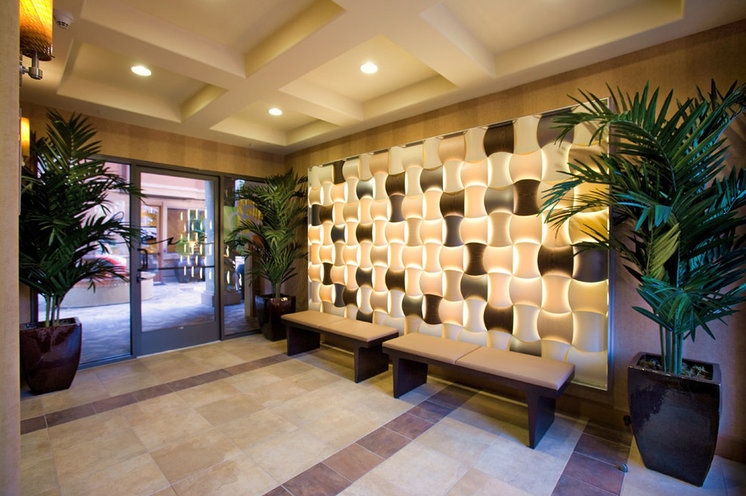The more unusual the material, the more personal a space can be. Unique materials aren't just fun — they can help a home become a personal expression of its owner.
Some of these products have been around for ages but were previously used in different contexts or environments; today's production techniques have helped simple materials achieve sophisticated designs. Other products are newcomers, still on the cusp of recognition.
Learn about the options below so you can make well-educated design decisions.
Woven resin. Woven 3-D surface wall treatment is from 3-Form. Available in many color options, it was once only seen in commercial projects but has become more popular in residences.
Three-D gypsum board. Modular Arts produces a wide variety of fiberglass-reinforced gypsum board panels. These panels come in tiles and are screwed to a substrate. The seams are mudded and sanded by a skillful drywaller to create a continuous effect.
Faux leather. Robin Reigi is my go-to supplier for this leather look-alike rubber product. It has a beautiful tactile warmth and is available in three different hues: natural, chocolate (shown here) and black.
Since it's a rubber product, it's easy to maintain and suitable for kitchen and bathroom cabinetry.
Stainless steel. Steel has amazing potential and can take on many different personalities, from modern and stark to tactile and warm.
Stainless steel isn't used just as a sheet metal today. In new applications, stainless steel pieces are linked together like chain mail or woven into screens.
Laminated glass. Laminated glass is made of various flat products sandwiched between two sheets of glass; it has a high-end, pressed look.
Colored glass works beautifully with this application, too. Mirror can be used as a backing for an opaque, reflective insert in a closest door. You can try playing with frosted glass, Starphire glass or different fabric inlays.
Laminated resin. Laminated resin is often used as a cabinet door insert or for lamp shades, but it can also be applied on a larger scale. The skillful mix of laminated resin in this photo gives a workspace the calm quality of a Japanese tearoom.
European laminates. High-pressure laminate fronts that show just how far laminate has come in the past few years. The Italians have been laminate masters since the 1950s — companies like Arpa, Abet and Laminati are some of my favorites. Today's laminates mimic textured faux woods, have 3-D effects and come in a range of colors and metallic surfaces.
Unfortunately, not all of these products are easy to find if you're not working with a design professional. I'd suggest getting samples from companies online and then taking them to a cabinetmaker who's open to working with these products.
Textured glass counters. Glass as a functional countertop material has been refined by the Canadian company ThinkGlass. Laminated layers of glass can be built up to 4 inches thick, with a wide range of textures for the bottom layer. The texture on the bottom creates an appealing visual effect and hides any surface scratches.
Bone. Bone has an ancient feel to it. The handmade quality of the individual tesserae, their elegant sheen and the subtle variety in hues make any application stunning.
Unfortunately, I have yet to find a producer for good sheets of bone mosaic. If you have a great source, please share it below!
Woven vinyl. Chilewich, well known for its placemats and runners, has a great product called Plynyl that can be used for wall-to-wall carpeting, carpet tiles and upholstery.
Although it's marketed as a commercial-grade product, Plynyl would make for great low-maintenance headboards or kitchen banquette upholstery. - Houzz
Need to speak with a home builder? Please do not hesitate to contact us at Landon Homes, (904)567-3430!

No comments:
Post a Comment